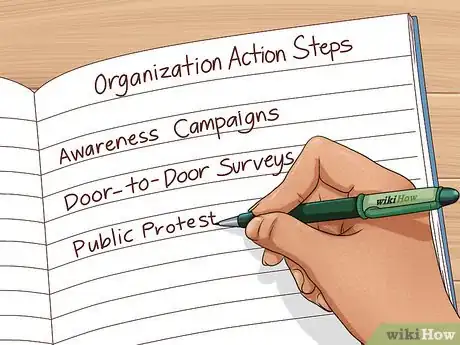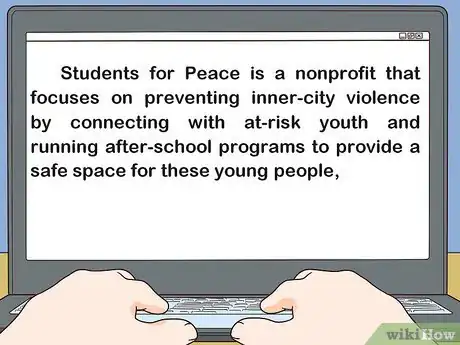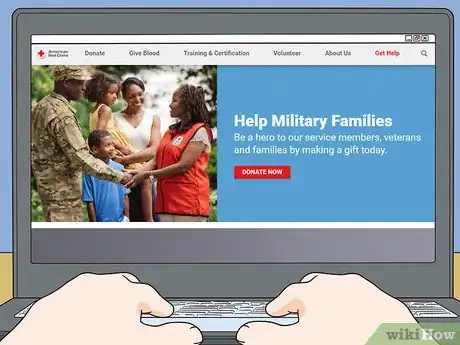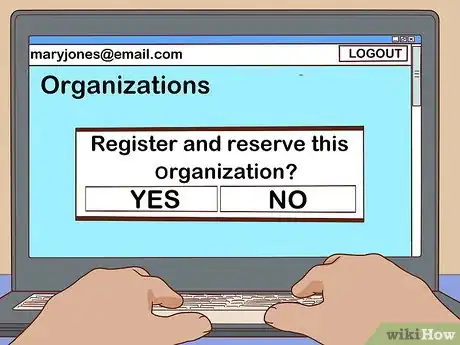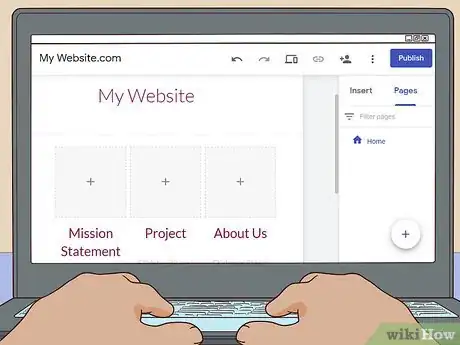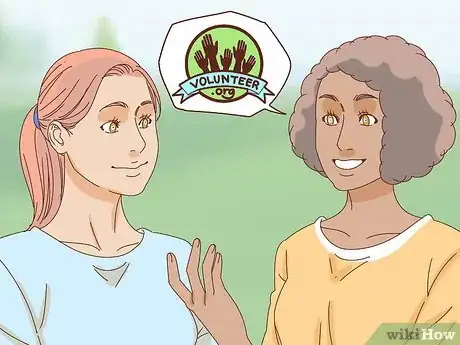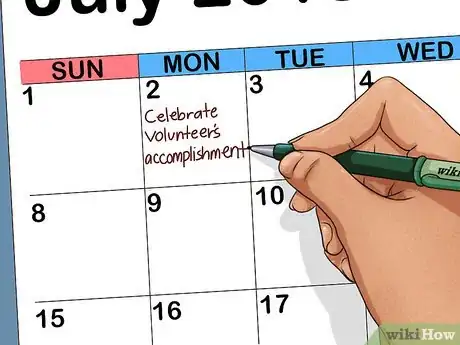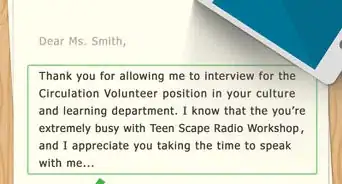This article was co-authored by wikiHow staff writer, Eric McClure. Eric McClure is an editing fellow at wikiHow where he has been editing, researching, and creating content since 2019. A former educator and poet, his work has appeared in Carcinogenic Poetry, Shot Glass Journal, Prairie Margins, and The Rusty Nail. His digital chapbook, The Internet, was also published in TL;DR Magazine. He was the winner of the Paul Carroll award for outstanding achievement in creative writing in 2014, and he was a featured reader at the Poetry Foundation’s Open Door Reading Series in 2015. Eric holds a BA in English from the University of Illinois at Chicago, and an MEd in secondary education from DePaul University.
There are 12 references cited in this article, which can be found at the bottom of the page.
wikiHow marks an article as reader-approved once it receives enough positive feedback. In this case, 100% of readers who voted found the article helpful, earning it our reader-approved status.
This article has been viewed 67,362 times.
Learn more...
Creating a volunteer organization can be a deeply fulfilling and fun process, but it requires a lot of hard work and dedication. Anyone can start a volunteer group with a positive attitude and patient mindset. To create a successful organization, you’ll want to carefully define your goals to craft a mission statement. From there, you can build a website, recruit online, and create a project for your organization to accomplish.
Steps
Designing a Mission
-
1Identify the specific elements of an issue to focus on. Most successful volunteer organizations focus on one specific issue, and identifying your main focus will inform how you design your organization. Brainstorm some issues that matter to you by freewriting on a piece of paper. Ask yourself what kind of change you want to see in the world and then narrow it down from there.[1]
- Your focus doesn’t need to be a massive issue like global warming or animal cruelty. It’s perfectly fine to focus on a smaller area of concern.
- If you’re struggling to think of an issue to focus on, start small. Ask people in your local community what they think could be improved where you live. You’re more likely to generate interest in your group if the people around you care about your topic.
-
2Select an obtainable goal in order to guide your organization. Think about how long it will take to solve the problems surrounding your particular issue, and use this information to estimate a timeline for your organization. People will want to know when their participation in your group could end, so consider starting with short-term obtainable goals.[2]
- It may be that there is no achievable solution to your problem in sight. In this case, consider creating an exploratory volunteer organization—a group that seeks to explore the dynamics of an issue.
- You could also create an awareness group to heighten people’s understanding of a topic, or a conservation organization—a group that focuses on saving a specific place or group from potential dangers.[3]
Advertisement -
3Determine the action steps that your organization will take. Start by writing down a few concrete steps that your organization will take to solve your issue. It’s alright if you aren’t sure about every practical detail at first, but you’ll need to be able to explain what your organization actually plans on doing in order to generate interest in your group.
- Awareness campaigns, door-to-door surveys, and public protests are all actionable steps that would serve as great places to start.
-
4Combine your focus, objection, and action steps to write a mission statement. A mission statement should explain your group’s goals and plans in one paragraph or less. Include an explanation of why your topic is important in order to justify your organization’s existence, and emphasize the specific group that you’re serving. If your organization wants to help pets, the environment, or a particular demographic of people, you’ll want to make that explicit in your mission statement.[4]
- For example, “Students for Peace is a nonprofit that focuses on preventing inner-city violence by connecting with at-risk youth and running after-school programs to provide a safe space for these young people,” is an excellent start to a mission statement. It explains why the group exists, who it serves, and how it helps.
- A mission statement is important because it guides every decision that an organization makes by anchoring it in a specific belief and orientation towards a problem.
- Ask a friend or colleague to proofread, edit, and revise your mission statement. You want it to be as tightly and carefully written as possible, since you’ll use it to appeal to your audience, recruit volunteers, and make major decisions.
-
5Create a name for your volunteer group. If you want attract volunteers and stick in your audience’s memory, you’ll want to think of a catchy name for your organization. Consider incorporating your group’s goal or location in your name. Say potential names out loud to see how the name sounds when spoken. Once you have a name, obtainable goals, and mission statement, you’re ready to get started.[5]
- American Red Cross, Habitat for Humanity, and Peace Corps are all organizations with great names because they’re memorable, catchy, and give you a sense of what their goal is in their name.
- An easy way to come up with a name is to use a simple formula. Take your volunteer demographic, use the word “for,” and then include the issue. Examples might look like “Citizens for Justice Reform,” or “Young Workers for a Higher Wage.”[6]
Creating a Foundation
-
1Register your organization with your state or country to make it official. Registering your organization will give it credibility and make it an official group. Every state and country has different laws and rules regarding the registration and incorporation of volunteer organizations. Do a thorough search online for laws regarding registration where you live, and file the necessary applications to make it official![7]
- Registering a nonprofit or volunteer organization typically requires you to pay a fee, but it often gives your organization protection from lawsuits and copyright infringement.[8]
-
2Create a website so that people can learn about your group. You’ll want to ensure that your website contains your mission statement, contact information, future projects, and information on how to get involved. Consider including a calendar or monthly meeting schedule so that volunteers can easily refer back to important dates or events. Try to keep your website simple in terms of design to ensure that it’s easy for people to navigate.
- Use a professional web address. A safe way to go is to simply use your group’s name as your web address if it’s available.
- Weebly, Ucraft, Wordpress, and Google Sites are all popular platforms that are used to create websites. They’re also free, and easy to use.[9]
- Squarespace is a popular website builder, but it’ll require a monthly payment plan.[10]
-
3Design promotional materials to market your group. Start with a simple brochure or poster. You can either design it yourself or use an online template. Include a call to action by asking your reader to do something specific, like vote on a particular topic or educate themselves on an issue. Tell the reader to refer to your website for more information, and include contact information about joining your group.[11]
- If you’re designing your marketing materials yourself, make sure that you don’t violate any copyright laws by including images without the owner’s permission. This could get you into big trouble as a registered nonprofit or volunteer organization.
Recruiting Members
-
1Approach close friends and family and ask them to help. People that know you intimately are going to be more inclined to help you at the beginning. Consider asking close friends and family to join as registered members of your organization. Even if they don’t meaningfully contribute, it’ll show future potential members that they aren’t alone in joining your group.
- Develop a quick pitch that can be delivered in one minute or less. Make sure that you explain your organization’s importance and how you plan to affect change.
-
2Promote your organization online by using social media. Join Facebook groups and follow Twitter hashtags that relate to your organization’s specific goals and overarching issues. This will help you identify people that may be interested in helping and give you an easy platform to promote your group. Encourage people to share your website, and use every opportunity to bring awareness to your topic.[12]
- A good social media post will start off with a call to action, followed by more specific details about your group. A strong call to action will activate interest in your group’s solution to a problem. “Save the whales!” or, “Don’t you want to improve life here in your city?” are both excellent openers because they provoke the reader to do something.
- Keep hashtags as short as possible in order to make sure that people remember them. They should include an action, whenever possible. “#StopLittering” is a perfect example of a simple hashtag that demands something from the audience.
-
3Create incentives for volunteers to attract new members. Incentives are an excellent way to get people excited about joining your group. They also increase morale and encourage involvement in your organization. Simple incentives like group outings, meals, snacks, and free t-shirts are excellent motivators that you can use to get people to join your group.[13]
- You can also appeal to an audience’s sense of belonging to attract members. Try playing up networking opportunities and telling potential members that they’d make a great fit in your organization.[14]
Taking Action and Growing as a Group
-
1Execute your organization’s first project. Start with something small and obtainable, like cleaning a section of roadway or creating a petition. You’ll want your first project to be something you can celebrate, so don’t get too ambitious at the beginning. If you start with a massive project, you could also overwhelm your first round of volunteers, which could scare them away in the future.[15]
- Be open to input from the members of your group. If they can’t get behind your idea, you’ll have a hard time convincing anyone to show up.
- Keep volunteers engaged by communicating often and finding something fun about your project. If you can listen to music while you work, consider bringing some speakers and playing some fun background tunes.[16]
- Have volunteers sign in by bringing a blank contact form so that you can reach out to active volunteers in the future.[17]
-
2Delegate responsibilities to other members in your group. Since they’re not being paid, it can often be hard to incentivize volunteers to take on additional work. Choose members that enjoy socializing for tasks that involve interacting with people. If there is someone in your group that loves to draw or paint, ask them to create your logo. A successful volunteer group requires a lot of effort, but if you can get your members to contribute in ways that interest them, you’ll develop group loyalty and make the organization feel more like a family.[18]
- Ask people about what motivates them directly. You may be able to delegate a lot of responsibilities to members that care deeply about your group’s mission. [19]
-
3Monitor results carefully and celebrate fellow volunteers. Discuss how things are going with fellow members to generate a growth plan. Be open to input from other members of your group when considering how effective a project has been. Make it a point to applaud your group’s efforts and celebrate them whenever you can. This will keep your volunteers returning to events and meetings!
- Keep a record of your work and growth by saving important events in a calendar. You can use a physical or digital calendar, but you’ll want to track events and membership in order to change your group’s direction in the future.
Community Q&A
-
QuestionHow can I help elderly people?
 Community AnswerOrganize a group of people to volunteer at, or just visit, nursing homes. I work at one, and you'd be surprised how many residents have no visitors.
Community AnswerOrganize a group of people to volunteer at, or just visit, nursing homes. I work at one, and you'd be surprised how many residents have no visitors. -
QuestionCan I start a volunteer organization as a teen?
 Community AnswerIf you have some adults that can help you with the legal and financial aspects, then yes, you could definitely help start a volunteer organization as a teen.
Community AnswerIf you have some adults that can help you with the legal and financial aspects, then yes, you could definitely help start a volunteer organization as a teen. -
QuestionDo I need any government licenses to start a voluntary organization?
 Community AnswerIt depends on what kind of voluntary organization. I remember from news people getting arrested because they handed food to the homeless, but the food wasn't checked.
Community AnswerIt depends on what kind of voluntary organization. I remember from news people getting arrested because they handed food to the homeless, but the food wasn't checked.
References
- ↑ https://www.inc.com/guides/2010/06/volunteer-program.html
- ↑ https://www.gooverseas.com/blog/five-types-volunteer-programs-and-how-find-right
- ↑ https://www.gooverseas.com/blog/five-types-volunteer-programs-and-how-find-right
- ↑ https://donorbox.org/nonprofit-blog/nonprofit-mission-statement/
- ↑ https://nonprofitally.com/start-a-nonprofit/choose-a-name/
- ↑ https://nonprofitally.com/start-a-nonprofit/choose-a-name/
- ↑ https://grantspace.org/resources/knowledge-base/starting-a-nonprofit/
- ↑ https://grantspace.org/resources/knowledge-base/starting-a-nonprofit/
- ↑ https://www.sitebuilderreport.com/free-website-builders
- ↑ https://www.sitebuilderreport.com/how-to-make-a-great-website
- ↑ https://www.cityofirvine.org/online-communications-toolkit/tips-creating-promotional-materials
- ↑ https://www.socialmediaexaminer.com/facebook-groups-for-business-how-to-guide-for-marketers/
- ↑ https://ctb.ku.edu/en/table-of-contents/maintain/reward-accomplishments/staff-volunteer-incentives/main
- ↑ https://ctb.ku.edu/en/table-of-contents/maintain/reward-accomplishments/staff-volunteer-incentives/main
- ↑ https://serve.ohio.gov/News-Events/Blog/PostId/1043/5-steps-to-organizing-a-community-volunteer-project
- ↑ https://serve.ohio.gov/News-Events/Blog/PostId/1043/5-steps-to-organizing-a-community-volunteer-project
- ↑ https://serve.ohio.gov/News-Events/Blog/PostId/1043/5-steps-to-organizing-a-community-volunteer-project
- ↑ https://vlcpa.com/articles/how-to-delegate-to-volunteers/84
- ↑ https://vlcpa.com/articles/how-to-delegate-to-volunteers/84


